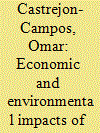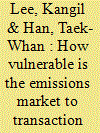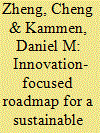|
|
|
Sort Order |
|
|
|
Items / Page
|
|
|
|
|
|
|
| Srl | Item |
| 1 |
ID:
186495


|
|
|
|
|
| Summary/Abstract |
Learning curve theory has been adopted for investigating the relationship between technological learning and technology cost developments. The aim of this paper is to explore the impacts of public investment in clean energy research, development, and demonstration (RD&D) on future technology cost developments by using a two-factor learning curve approach. Learning-by-deploying and learning-by-researching were chosen as the main sources of learning. The focus is on onshore wind and solar photovoltaics in the United States of America. By using publicly available data, we estimated learning-by-deploying rates of 31.4% and 27.6%; and learning-by-researching rates of 2.3% and 4.7% for onshore wind and solar PV, respectively. By adopting a logistic curve approach, an additional $1322 and $819 mil. were forecast to be spent by 2050 in RD&D for onshore wind and solar PV, respectively. We explored the plausible long-term effects of diverse RD&D investment scenarios on electricity generation and greenhouse gas (GHG) emissions using a system dynamics model. The findings reveal that public investment in RD&D for clean energy technologies may play a key role in the pace of capital cost reductions and technology diffusion. However, relatively little long-term effects of RD&D efforts alone were found on market dynamics and GHG emissions.
|
|
|
|
|
|
|
|
|
|
|
|
|
|
|
|
| 2 |
ID:
171478


|
|
|
|
|
| Summary/Abstract |
Renewable energy electricity, such as photovoltaic (PV) power generation, has the benefits of strengthening energy security, addressing climate change, reducing air pollution, etc., but there are some impediments to deployment of renewable energy electricity: higher costs than fossil fuels, intermittent energy production, site constraints, etc. Korea changed its renewable energy electricity support systems from feed-in tariff (FIT) to a renewable portfolio standard (RPS) in 2012. This study evaluates FIT versus RPS in terms of the time to reach grid parity for PVs. Using a learning curve model, we calculate the learning rate of PV power generation during the FIT and RPS periods. We find that the PV learning rate during the RPS period was 18.44%, much higher than that during the FIT period, −0.28%, and R2 is 0.9861 and 0.7346 in the RPS and FIT periods, respectively. Using the calculated learning rate in the RPS period, we also predict that grid parity for PVs is expected in 2025 in Korea.
|
|
|
|
|
|
|
|
|
|
|
|
|
|
|
|
| 3 |
ID:
150830


|
|
|
|
|
| Summary/Abstract |
The impact of transaction costs on the early emissions trading market is examined by applying an agent-based model and simulation (ABMS) approach. For a realistic model set up, bounded rationality, stochastic characteristics, and learning-by-doing are considered in our search processes. Marginal abatement cost parameters are obtained from Yoo et al. (2010), which is an experimental study on the emissions trading in the Korean power sector. Sensitivity analyses are performed on market performance indices with regard to transaction cost parameters, which represent scales and the learning elasticities of transaction costs. A total of 960 simulations were run in this sensitivity analysis. Sensitivity analysis results consistently show that higher transaction costs worsen market performance. The most remarkable finding in these results is that welfare performance of all the transactions decreases by up to 50% as the scale parameters of transaction costs increase, implying that welfare gain from introducing emissions trading disappears significantly. However, with learning curve effect, welfare performance could be regained by up to 26%. In sum, although transaction costs significantly encroach upon trade gains at the early stage, based on our simulation results, the welfare loss by way of transaction costs is lessened as the knowledge of market participants progresses.
|
|
|
|
|
|
|
|
|
|
|
|
|
|
|
|
| 4 |
ID:
128347


|
|
|
|
|
| Publication |
2014.
|
| Summary/Abstract |
The solar photovoltaic (PV) industry has undergone a dramatic evolution over the past decade, growing at an average rate of 48 percent per year to a global market size of 31 GW in 2012, and with the price of crystalline-silicon PV module as low as $0.72/W in September 2013. To examine this evolution we built a comprehensive dataset from 2000 to 2012 for the PV industries in the United States, China, Japan, and Germany, which we used to develop a model to explain the dynamics among innovation, manufacturing, and market. A two-factor learning curve model is constructed to make explicit the effect of innovation from economies of scale. The past explosive growth has resulted in an oversupply problem, which is undermining the effectiveness of "demand-pull" policies that could otherwise spur innovation. To strengthen the industry we find that a policy shift is needed to balance the excitement and focus on market forces with a larger commitment to research and development funding. We use this work to form a set of recommendations and a roadmap that will enable a next wave of innovation and thus sustainable growth of the PV industry into a mainstay of the global energy economy.
|
|
|
|
|
|
|
|
|
|
|
|
|
|
|
|
| 5 |
ID:
113465


|
|
|
|
|
| Publication |
2012.
|
| Summary/Abstract |
In order to reduce CO2 emissions in the passenger vehicle sector, mass introduction of electric vehicles (EVs) and plug-in hybrid electric vehicles (PHEVs) is required despite their high battery costs. This paper forecasts the rate at which EV/PHEV will penetrate into the market in the future and the effects of that spread on CO2 reduction by using a learning curve for lithium-ion batteries, distribution of daily travel distance for each vehicle, and an optimal power generation planning model for charging vehicles. Taking into consideration each driver's economical viewpoint, the speed at which the EV/PHEV share of the new passenger vehicle market grows is fairly slow. The optimum calculation in our base case shows that the share of EV/PHEV is only a quarter even in 2050. However, the initial price and progress rate of batteries have a great effect on this share. Therefore, long-term economic support from the government and significant R&D innovation are required to reduce CO2 drastically through cutting down battery price. The results also show how much the CO2 emission intensity of power generation affects the CO2 reduction rate by introducing EV/PHEV.
|
|
|
|
|
|
|
|
|
|
|
|
|
|
|
|
| 6 |
ID:
125624


|
|
|
|
|
| Publication |
2013.
|
| Summary/Abstract |
From an economic viewpoint, a larger reduction in the level of economic support to facilitate renewable energy installations, e.g., the purchase price of renewable electricity under a feed-in tariff scheme, is not necessarily rational in accordance with a larger decline in the observed cost of the installation, if the expected cost decline of the renewable technology is to be revised in response to the newest statistical data observed during each passing time period. This paper demonstrates this point through an analysis of a case of Japanese photovoltaic power generation deployment.
|
|
|
|
|
|
|
|
|
|
|
|
|
|
|
|
| 7 |
ID:
149915


|
|
|
|
|
| Summary/Abstract |
Experience curves are useful for understanding technology development and can aid in the design and analysis of market transformation programs. Here, we employ a novel approach to create experience curves, to examine both global and North American compact fluorescent lamp (CFL) data for the years 1990–2007. We move away from the prevailing method of fitting a single, constant, exponential curve to data and instead search for break points where changes in the learning rate may have occurred. Our analysis suggests a learning rate of approximately 21% for the period of 1990–1997, and 51% and 79% in global and North American datasets, respectively, after 1998. We use price data for this analysis; therefore our learning rates encompass developments beyond typical “learning by doing”, including supply chain impacts such as market competition. We examine correlations between North American learning rates and the initiation of new programs, abrupt technological advances, and economic and political events, and find an increased learning rate associated with design advancements and federal standards programs. Our findings support the use of segmented experience curves for retrospective and prospective technology analysis, and may imply that investments in technology programs have contributed to an increase of the CFL learning rate.
|
|
|
|
|
|
|
|
|
|
|
|
|
|
|
|
| 8 |
ID:
096114


|
|
|
|
|
| Publication |
2010.
|
| Summary/Abstract |
Fuel cells have gained considerable interest as a means to efficiently convert the energy stored in gases like hydrogen and methane into electricity. Further developing fuel cells in order to reach cost, safety and reliability levels at which their widespread use becomes feasible is an essential prerequisite for the potential establishment of a 'hydrogen economy'. A major factor currently obviating the extensive use of fuel cells is their relatively high costs. At present we estimate these at about 1100 €(2005)/kW for an 80 kW fuel cell system but notice that specific costs vary markedly with fuel cell system power capacity. We analyze past fuel cell cost reductions for both individual manufacturers and the global market. We determine learning curves, with fairly high uncertainty ranges, for three different types of fuel cell technology - AFC, PAFC and PEMFC - each manufactured by a different producer. For PEMFC technology we also calculate a global learning curve, characterised by a learning rate of 21% with an error margin of 4%. Given their respective uncertainties, this global learning rate value is in agreement with those we find for different manufacturers. In contrast to some other new energy technologies, R&D still plays a major role in today's fuel cell improvement process and hence probably explains a substantial part of our observed cost reductions. The remaining share of these cost reductions derives from learning-by-doing proper. Since learning-by-doing usually involves a learning rate of typically 20%, the residual value for pure learning we find for fuel cells is relatively low. In an ideal scenario for fuel cell technology we estimate a bottom-line for specific (80 kW system) manufacturing costs of 95 €(2005)/kW. Although learning curves observed in the past constitute no guarantee for sustained cost reductions in the future, when we assume global total learning at the pace calculated here as the only cost reduction mechanism, this ultimate cost figure is reached after a large-scale deployment about 10 times doubled with respect to the cumulative installed fuel cell capacity to date.
|
|
|
|
|
|
|
|
|
|
|
|
|
|
|
|
| 9 |
ID:
090248


|
|
|
|
|
| Publication |
2009.
|
| Summary/Abstract |
Debates over whether to require voters to provide proof of identity at the polls, and just how that can be accomplished, are taking place in legislative chambers and courtrooms across the nation. At the heart of these debates is the balancing act of ballot security versus access to voting. Opponents of voter-identification requirements argue that they place a disproportionate burden on ethnic and racial minorities, the poor, the less educated, the very young, and the very old. Supporters of identification requirements argue the standards are no higher than those required for boarding a plane or cashing a check, and the requirements are needed to prevent voter fraud.
|
|
|
|
|
|
|
|
|
|
|
|
|
|
|
|
|
|
|
|
|